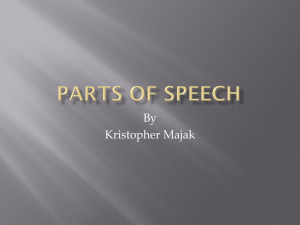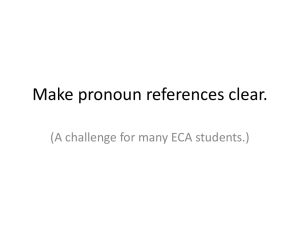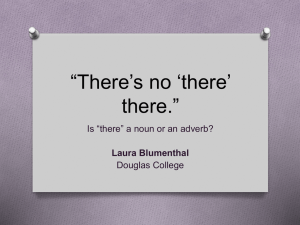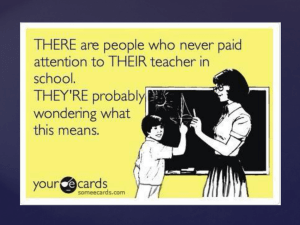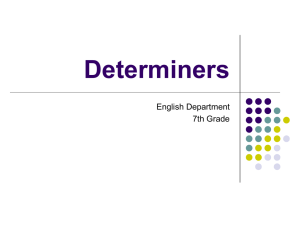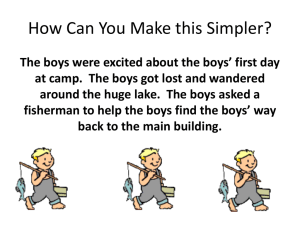AP Style and grammar
advertisement
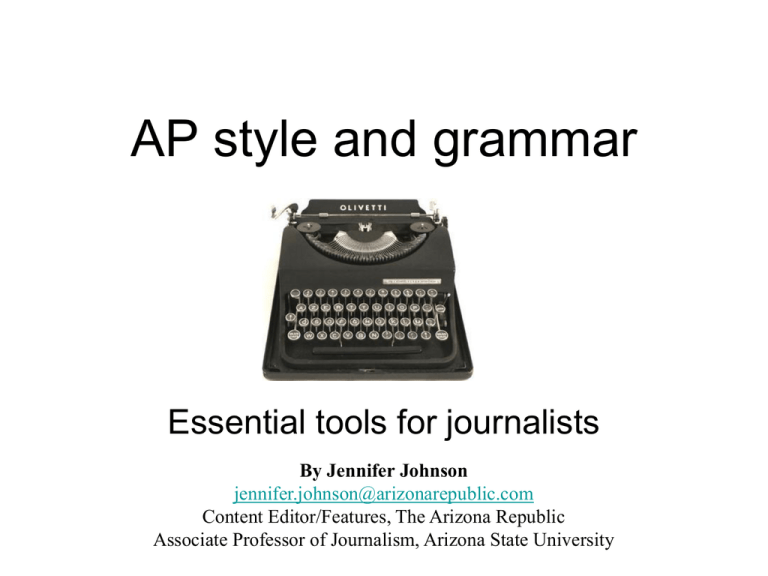
AP style and grammar Essential tools for journalists By Jennifer Johnson jennifer.johnson@arizonarepublic.com Content Editor/Features, The Arizona Republic Associate Professor of Journalism, Arizona State University Then. Now. A lot has changed… …but some things haven’t. The essentials: Writing and editing Accuracy and fairness Grammar and style Grammar has always been around (even if we don’t always “get” it) … but what about style? In 1953, journalists finally got some style. Meet the Associated Press Stylebook. What is AP style? • The “rulebook” for newswriting. • As AP says, it’s “part dictionary, part textbook, part encyclopedia.” Can’t I just use google? No. And here’s why: The AP Stylebook was created to give an accurate, consistent presentation of the printed word. How many opportunities for inconsistent presentation can you find below? At an E.U. summit yesterday, President George W. Bush spoke to twenty-seven leaders about United States policies in the Mideast. Did you count six? At an E.U. summit yesterday, President George W. Bush spoke to the twenty-seven leaders about United States policies in the Mideast. Same paragraph, adjusted for AP style: At a European Union summit Tuesday, President Bush spoke to the 27 member states about U.S. policies in the Middle East. Even if spelling variations are correct, they’re confusing: Al-Qaida Al-Qaeda al-Qaida Al qaida al-Qaeda Al Qaida Avoid confusion by following a consistent style. Al-Qaida Al-Qaeda al-Qaida (AP style) Al qaida al-Qaeda Al Qaida Why your students need AP Style: Position: Internship Company: Chicago Tribune Requirements: “…you’ll also need to have a solid knowledge of AP style…” Why your students need AP style: Position: Sports Reporter Company: The Arizona Daily Sun Job Status: Full-time Requirements: “…the ideal candidate has a firm grasp of AP style…” Why your students need AP Style: Position: Web News Editor Location: Detroit, Michigan Job Status: Full-time Requirements: “…must have knowledge of editing and AP Stylebook standards. A writing/editing test will be given…” Your students need to know: 1. What to look up. 2. How to find it. Let’s take a tour… What to look up: The basics • • • • • Proper nouns Numbers Time references Directions and regions Abbreviations/acronyms Proper nouns The stylebook tells you when and why to capitalize nouns. The Democratic Party sponsored a rally outside Gov. O’Neill’s office. But… The party sponsored a rally outside the governor’s office. Proper nouns Some basic AP rules: Capitalize nouns that constitute the unique identification for a specific person, place or thing. Examples: John, Mary, America, Boston, England Proper nouns Some basic AP rules: Capitalize common nouns such as party, river, street and west when they are an integral part of the full name for a person, place or thing. Examples: Democratic Party, Mississippi River, Fleet Street, West Virginia Proper nouns BUT: Lowercase those common nouns when they stand alone in subsequent references: the party, the river, the street Proper nouns Other rules (and exceptions) are found throughout the stylebook, under entries such as: • • • • • • Brand names Historical periods Governmental bodies Nationalities and races Organizations Trademarks What to look up: The Basics • • • • • Proper nouns Numbers Time references Directions and regions Abbreviations/acronyms Numbers The stylebook tells you when and why to use numerals or spell them out. He invited two of his friends. But… He has a 2-year-old daughter. Numbers Some basic AP rules: Spell out whole numbers below 10, and use figures for 10 and above. Example: I’ll bring six cans of soda and 12 paper plates to the picnic. Numbers BUT: With ages, always use figures for people and animals (but not inanimate objects). Examples: The 5-year-old boy. The 10-year-old girl. The boy, 5, has a sister, 10. My parents are in their 70s. Numbers Other rules (and exceptions) about numbers are found under entries such as: • • • • • • addresses dates dimensions percent speeds times What to look up: The Basics • • • • • Proper nouns Numbers Time references Directions and regions Abbreviations/acronyms Time references The stylebook tells you how to present the time of day, the day of week, a calendar date, year or decade. The New Year’s countdown begins at 11:59 p.m. or Crime rates spiked in the 1980s. Time references Some basic AP rules: Use figures except for noon and midnight. Only use a colon to separate hours from minutes: 11 a.m. (not 11:00 a.m.) But… 11:03 a.m. Time references Some basic AP rules: Avoid such redundancies as: 7 a.m. Thursday morning (AP style is 7 am. Thursday) Time references Some basic AP rules: Do not abbreviate days of the week. Use the day of the week (Monday, Tuesday, etc.) rather than using today, tomorrow or yesterday. Time references Some basic AP rules: • For a month with a specific date, abbreviate all but March, April, May, June, July. Example: Dec. 25, 1999. • For a month with a year, do not separate with commas: January 1972 • For a month, day and year, set off the year with commas: Jan. 2, 1972. Time references Some basic AP rules: When referring to a decade, show a plural by adding the letter s: the 1920s. (Note: no apostrophe before the s) But … Use an apostrophe to indicate numerals that are left out: the ’20s. What to look up: The Basics • • • • • Proper nouns Numbers Time references Directions and regions Abbreviations/acronyms Directions and regions The stylebook tells you when to capitalize/lowercase or when to abbreviate/spell out the names of compass directions, regional designations and states. Directions and regions Some basic AP rules: In general, lowercase north, south, northeast, etc., for compass direction. Example: The storm headed east. But … Capitalize when they designate regions. Example: The storm hit the Midwest and headed for the East Coast. Directions and regions Some basic AP rules: Lowercase compass points when they describe a section of a state or city (eastern Idaho, northern Arizona) But … Capitalize when part of a proper name (West Virginia, North Korea) or a widely known area (Southern California). Directions and regions Some basic AP rules: State names should be spelled out when they stand alone. (Montana) But … Abbreviate them in conjunction with a city, county or town. (Missoula, Mont.) (Note: Do not use two-letter Postal Service abbreviations unless full mailing address) Directions and regions Exception to the rule: Eight states are not abbreviated in text: Alaska, Hawaii, Idaho, Iowa, Maine, Ohio, Texas and Utah. A tip for remembering the eight: Two are the states not part of contiguous U.S. The rest are states with five letters or fewer. What to look up: The Basics • • • • • Proper nouns Numbers Time references Directions and regions Abbreviations/acronyms Abbreviations & acronyms The stylebook tells you when it’s appropriate to abbreviate or use acronyms and how to do so correctly. • • • • NASA (not N.A.S.A or written out) No. 1 (not Number One or number 1) John F. Kennedy Jr. (not Junior) OK (not okay) Abbreviations & acronyms Some basic AP rules: BEFORE a name: Abbreviate formal titles. • • • • • Dr. Joyce Brothers Gov. Schwarzenegger Rep. Newt Gingrich the Rev. Al Sharpton Sen. Harry Reid Abbreviations & acronyms Some basic AP rules: AFTER a name: Abbreviate junior or senior. Abbreviate company, corporation, incorporated and limited. Examples: • Hank Williams Jr. (Note: no comma before Jr.) • PepsiCo Inc. • Exxon Mobil Corp. Abbreviations & acronyms Some basic AP rules: Don’t follow an organization’s full name with an acronym in parentheses. (NOTE: If the acronym wouldn’t be commonly known on second reference, don’t use it.) National Rifle Association (NRA) National Rifle Association (use NRA on second reference in story). Abbreviations & acronyms Other rules are found throughout the stylebook, under entries such as: • • • • • • • Company names Courtesy titles Military titles Religious titles Academic titles / Academic degrees Organizations and institutions Judge / Court names The secret to mastering style 1. Don’t panic. Nobody is expected to memorize the whole stylebook. (After all, it’s 419 pages long!) The secret to mastering style 2. Master the basics. The most common rules and topical entries (like the ones in this presentation) will become familiar very quickly. The secret to mastering style 3. Get in the habit. Train yourself to stop and look up any word(s) that could be presented in varying ways. P.S. A lot of words fall under this category. Now … ready for a style quiz? www.newsroom101.com Let’s play “word association.” What comes to mind when you hear the word grammar ? Your 6th-grade English teacher? Mrs. Crabtree Mrs. Crabtree was right. Grammatical rules are ignored at every level of our society. Here’s how it affects students (and everyone): • Our ears are accustomed to hearing incorrect usage. Wrong sounds right. • Our writing is riddled with errors, and we don’t even know it. 4 grammar topics to teach (and re-teach) journalism students 1. Parts of speech 2. Subject-verb agreement 3. Pronoun case 4. Plurals v. possessives Parts of speech Bring back memories? (or nightmares?) Parts of speech Sentence-diagramming threats aside… … the basics are worth revisiting. Parts of speech Your students probably know that a noun is a “person, place or thing,” but how many can easily describe a preposition or conjunction? Can they explain the difference between adjectives and adverbs? Parts of speech 1. Noun: A person, place or thing. 2. Verb: A word that describes an action or a state of being. 3. Pronoun: A noun “substitute.” 4. Adjective: Describes a noun. 5. Adverb: Describes a verb, adjective or another adverb. 6. Preposition: Works with nouns and pronouns to create phrases. 7. Conjunction: Links words, phrases and clauses. 8. Interjection: Gives emotion and outburst. Parts of speech Can you identify all eight parts of speech in the following sentence? Armed guards chased him out of the bank, and they repeatedly yelled “Stop!” Parts of speech Armed guards chased him adj. n. v. pron. out of the bank, and they prep. conj. repeatedly yelled “Stop!” adv. interj. 4 grammar topics to teach (and re-teach) journalism students 1. Parts of speech 2. Subject-verb agreement 3. Pronoun case 4. Plurals v. possessives Subject-verb agreement Agreement errors are everywhere. Why? They sound right. The school of dolphins were visible from the shore. Subject-verb agreement “Disagreement” occurs when one is singular and the other is plural. The school of dolphins were visible from the shore. (“school” is the singular subject, so the correct verb should be was) Subject-verb agreement Common problem: Collective nouns family, group, team, band, jury, committee, class, etc. They generally take singular verbs. Subject-verb agreement TIP for tackling collective nouns: Mentally cross out the prepositional phrase after a collective noun. This removes any confusion your ear (or eyes) may experience. A team of cyclists was training today. Subject-verb agreement Common problem: Complex constructions such as “one of … who/that…” Tennis is one of those sports that requires/require healthy knees. Subject-verb agreement Tennis is one of those sports that requires/require healthy knees. a. Find the relative pronoun (that) b. Find the antecedent (sports) c. The verb must agree with the antecedent, so it’s “require.” Subject-verb agreement TIP for tackling “one of … who/that…” Mentally invert the sentence. Of those sports that require healthy knees, tennis is one. 4 grammar topics to teach (and re-teach) journalism students 1. Parts of speech 2. Subject-verb agreement 3. Pronoun case 4. Plurals v. possessives Pronoun case Even our ears know that a pronoun changes form when its role in a sentence changes. Simple changes come naturally: We are giving them the tickets. They are giving us the tickets. Pronoun case But many students don’t know why or when to change case, and that spells trouble when sentences are more complex. How often do you hear the comments on the next page? Pronoun case “Her and me are going to the movies.” “Me and you should play hoops today.” “Dad gave him and I the extra tickets.” Each of these is common. And wrong. Pronoun case Sometimes, there are no shortcuts. Know this chart. Memorize it. Obey it. =) Nominative Objective Possessive (subjective) I you he she who it we they me you him her whom it us them my/mine your/yours his her/hers whose its our/ours their/theirs Pronoun case Use the nominative case for: The subject of a verb: She ran the race. The complement of a linking verb: It is he. An appositive in the subjective case: We journalists need to learn grammar. Pronoun case Use the objective case for: The object of the verb: Bill showed me the way. The object of a preposition: The gift is for us. An appositive in the objective case: She gave the gift to us girls. Pronoun case Pop quiz: Which is correct? Tom and me are going to the theater. Tom and I are going to the theater. Please save seats for Tom and me. Please save seats for Tom and I. Pronoun case It was her who told me about the robbery. It was she who told me about the robbery. Between you and I, John failed the test. Between you and me, John failed the test. Pronoun case Tom and me are going to the theater. WRONG Tom and I are going to the theater. RIGHT Please save seats for Tom and me. RIGHT Please save seats for Tom and I. WRONG Pronoun case It was her who told me about the robbery. WRONG It was she who told me about the robbery. RIGHT Between you and I, John failed the test. WRONG Between you and me, John failed the test. RIGHT Pronoun case Common problem: Who v. whom? Two strategies: #1: If it’s a question, answer it. Who/whom will you take to prom? (I will take him.) him=whom (they’re both objective case), so: Whom will you take to prom? Pronoun case Common problem: Who v. whom? #2: Determine whether who/whom is acting as a subject or an object in its clause. She is the senator who/whom voted for a tax cut. Pronoun case Common problem: Who v. whom? #2: In other words, find the verb and determine whether who/whom is performing or receiving the action. She is the senator who/whom voted for a tax cut. The pronoun is performing the action (voted). That makes it the subject. So who is the correct choice. Pronoun case Common problem: Who v. whom? Practice makes perfect. Send your students here for more fun: www.newsroom101.com 4 grammar topics to teach (and re-teach) journalism students 1. Parts of speech 2. Subject-verb agreement 3. Pronoun case 4. Plurals v. possessives Plurals v. possessives Why are plurals and possessives so confusing? Here’s why… Plurals v. possessives First, there are rules for pronouns: No apostrophe with personal pronoun possessives (its, hers, his, theirs, whose). (One of the most common errors: it’s) Plurals v. possessives Then, there are rules for common nouns: Plural: The actresses are required to wear black. Singular possessive: The actress’s paycheck was lost. The actress’ salary requirements are high. Plural possessive: The actresses’ paychecks were lost. Plurals v. possessives Finally, there are rules for proper nouns (and even more rules for those pesky names that end in “s”): Singular possessive: Bill Smith’s lawn. Mike Jones’ lawn. Plural: The Smiths arrived. The Joneses arrived. Plural possessive: The Smiths’ house. The Joneses’ house. A couple of tips to take home: In some cases, memorizing a funny little phrase can help with a grammar rule. Choosing a relative pronoun: He is on the Senate panel who/that voted today. Memorize: Who is a human, that is a thing. In this sentence, the relative pronoun is referring to the panel (a thing). So: that. A couple of tips to take home: Choosing an adjective v. adverb: James plays the piano bad/badly. Memorize: I feel bad that I behaved badly. This little phrase reminds you to: •Use an adjective (bad) with a linking verb (feel). •Use an adverb (badly) with an action verb (behaved). Plays is an action verb, so: badly. Study tools/resources www.newsroom101.com This top-notch site created by journalism educators has nearly 2,000 interactive exercises on AP style, grammar, punctuation and much more. www.newsu.org The Poynter Institute offers more than 60 online training sessions, including a handful of editingrelated topics such as cleaning up copy or rewriting stories. Study tools/resources The Cronkite School recommends: owl.english.purdue.edu/owl/: Find a “grammar, punctuation, and spelling” collection of links. Also recommended: Big Dog’s Grammar: www.aliscot.com/bigdog/ Grambo: A Test of the Emergency Grammar System (John Russial’s site from the University of Oregon): http://jcomm.uoregon.edu/~russial/grammar/grambo.html#the test Sentence Diagrams, Eugene R. Moutoux: http://www.geocities.com/gene_moutoux/diagrams.htm Common Errors in English, Paul Brians: http://www.wsu.edu/~brians/errors/errors.html (be sure to scroll down to see the goodies) And don’t forget this study tool … The back pages of the stylebook have special sections devoted to grammar, word use and punctuation. Any other tips for us, Mrs. Crabtree? “Study.”
